Trees Birds Mammals Fish Amphibians Reptiles
Wild Algarve
Bookshop
Aleuria aurantia (Pers.) Fuckel - Orange Peel Fungus
Phylum: Ascomycota - Class: Pezizomycetes - Order: Pezizales - Family: Pyronemataceae
Distribution - Taxonomic History - Etymology - Identification - Culinary Notes - Reference Sources
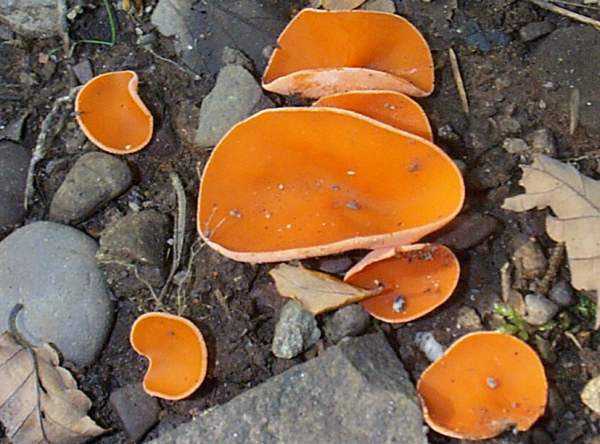
Aleuria aurantia, the Orange Peel Fungus, is
initially cup shaped but develops into a contorted bowl, often
splitting. It is most frequently found on disturbed soil beside woodland
paths.
Distribution
A fairly common find in Britain and Ireland, Orange Peel Fungus occurs also throughout mainland Europe, from Scandinavia right down to the southern shores of the Iberian Peninsula. This species is also found in North America.
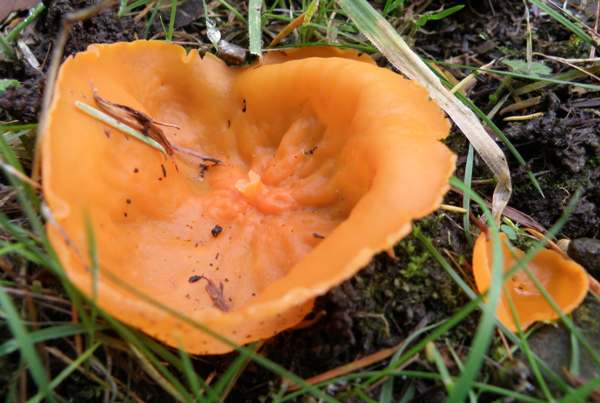
Taxonomic history
In 1799 when Christiaan Hendrik Persoon described this species he named it Peziza aurantia.
It was the German mycologist Karl Wilhelm Gottlieb Leopold Fuckel (1821 - 1876) who transferred Orange Peel Fungus to the genus Aleuria and gave it its present scentific name Aleuria aurantia in 1870.
Synonyms of Aleuria aurantia include Peziza aurantia Fr., Scodellina aurantia (Pers.) Gray, Peziza coccinea Huds., Helvella coccinea Bolton, and Peziza aurantia Pers.
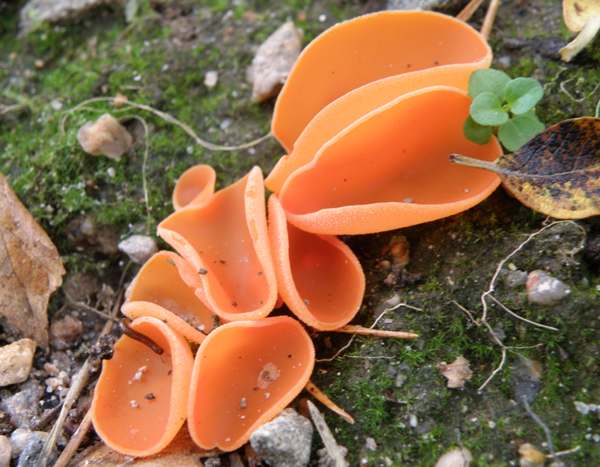
Etymology
The specific epithet aurantia means 'golden' is a reference to the colour of the fertile surface of these cup fungi.
Although usually starting out as concave cup-like fruitbodies, sometimes the Orange Peel Fungus turns convex, as in the example above, and then it looks even more like orange peel. Recently cleared stony forestry tracks are particularly good places for pezizoid fungi, and Aleuria aurantia in particular seems to favour such exposed locations.
Identification guide
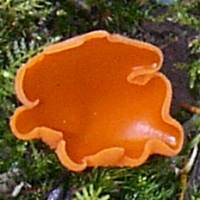 |
Fertile (inner) surface
These striking fungi vary in colour from pale orange through to a
very deep orange-red inside the cup, while the lower (outer, in cup-shaped fruitbodies) surface is paler
and covered in a very fine whitish down.
The cups are initially round but soon develop
wavy margins and have a tendency to split.
Up to 10cm across, but more
commonly 3 to 6cm, they are shiny on the inside (hymenial or spore-bearing)
surface and downy on the outside. |
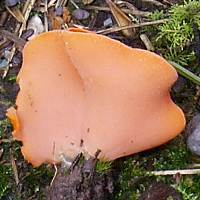 |
Infertile (outer) surface and stem
The cup is typically 2 to 4cm tall
and is attached to the soil by mycelial threads and without a visible
stipe.
The pale outer surface of the cup is infertile; the spores are produced on the shiny inner surface of the cup. |
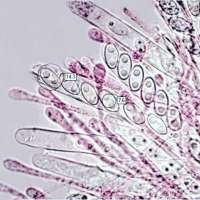 |
Asci
185-200 x 10-13µm, with eight spores per ascus.
|
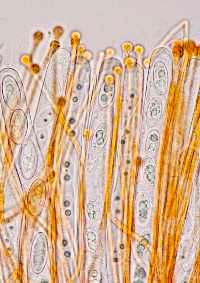 |
Paraphyses
Narrow, clavate.
Paraphyses are structures of sterile tissue between the asci on the hymenial surface.
|
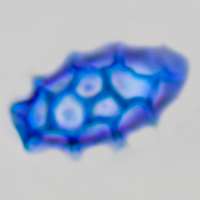 |
Spores
Ellipsoidal, with a coarsely reticulate surface, 17-24 x 9-11µm (including ornamentation); spores usually containing two small oil drops, sometimes with thorn-like projections at each end.
Spore print
White. |
Odour/taste |
Not distinctive. |
Habitat & Ecological role |
Saprobic, on and beside disturbed paths, particularly
on gravelly soil. |
Season |
August to early November in Britain and Ireland; later in southern parts of mainland Europe. |
Similar species |
Sarcoscypha austriaca, the Scarlet Elf Cup, is bright red
and grows on dead twigs and branches, in mossy woods and sometimes under damp hedgerows. |
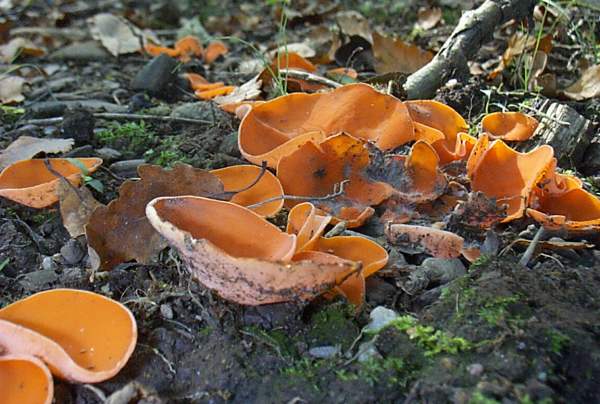
Culinary Notes
This is one of the very few common cup fungi that are edible; most of the
others are in varying degrees poisonous, although some become edible if
thoroughly cooked. Unfortunately, despite its attractive appearance, the Orange Peel
Fungus is not particularly tasty, and so it is rarely used in cooking except perhaps to add colour to salads.
Reference Sources
Fascinated by Fungi, 2nd Edition, Pat O'Reilly 2016, reprinted by Coch-y-bonddu Books in 2022.
Dennis, R.W.G. (1981). British Ascomycetes; Lubrecht & Cramer; ISBN: 3768205525.
Breitenbach, J. & Kränzlin, F. (1984). Fungi of Switzerland. Volume 1: Ascomycetes. Verlag Mykologia: Luzern, Switzerland.
Medardi, G. (2006). Ascomiceti d'Italia. Centro Studi Micologici: Trento.
Dictionary of the Fungi; Paul M. Kirk, Paul F. Cannon, David W. Minter and J. A. Stalpers; CABI, 2008
BMS List of English Names for Fungi
Taxonomic history and synonym information on these pages is drawn from many sources but in particular from the British Mycological Society's GB Checklist of Fungi.
Acknowledgements
This page includes pictures kindly contributed by David Kelly.
Top of page...
Fascinated by Fungi. Back by popular demand, Pat O'Reilly's best-selling 450-page hardback book is available now. The latest second edition was republished with a sparkling new cover design in September 2022 by Coch-y-Bonddu Books. Full details and copies are available from the publisher's online bookshop...